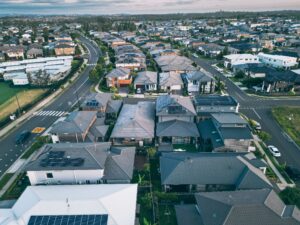Telstra shares are at a 10-year high and the company is at an exciting point in its history

Last time we wrote about Telstra shares, it was in mid-FY24 and the company was under pressure. But 15 months on, things have improved with a strong FY25 and the company telling investors to expect the rest of the 2020s to deliver the goods. The company has never reached highs seen in 2015 since then, but is right now as close to that point as it has ever been.
The telco field is highly competitive, but it is a ‘staple’ if ever there was one. And even though the days of Telstra having a monpoly are gone, it has the next best thing: A dominant market share.
What are the Best ASX Stocks to invest in right now?
Check our buy/sell tips

Introduction to Telstra
Telstra traces its origins back to 1901 when the new government of federated Australia set up the Postmaster-General’s Department (PGD) to run all telephone, telegraph and postal services in Australia. Over time, these all demerged into separate entities. Today’s Telstra was founded in 1991 when the sector was deregulated, and the company was gradually privatised between 1997 and 2006.
It has never been the same since its privatisation because it lost its monopoly and has had to compete with other companies. In the early days it was just Optus, and now it is several companies ranging from Optus and Vodafone to more nimble players like Aussie Broadband (ASX:ABB).
Yes, there have been some good periods, including the tenures of Sol Trujillo and David Thodey as CEO, and the company has kept pace with technological development – although it has never been as well off as it would have been had it kept a monopoly. But there have been difficult times. It lost $46bn of shareholder value during the tenure of Andrew Penn not just due to competition but its own network outages and sinking bottom line.
Telstra shares are under pressure from immediate challenges
But let’s go to the more immediate past. The company hired CEO Vicki Brady in 2022 to replace Andy Penn. She had an admirable rise to the top, starting her career pouring beers in her father’s pub and working her was up the corporate ladder. She suffered a cancer diagnosis in 2018 but recovered and was hired as CFO in 2019, serving until her promotion to the top job.
Beyond the ever growing competition, there is also pressure on Telstra’s network traffic due to streaming services and AI applications not to mention people making calls over the internet instead of through traditional voice calls. Consumers and businesses, reeling from the cost of living crisis, are prepared to hunt around for bargains.
And there is pressure from investors to diversify its earnings generally and to adopt AI ahead of its competitors. Perhaps investors have seen their cries answered as the company unveiled its Connected Future 30 back in May.
Artificial Intelligence and ‘Connected Future 30’ to the rescue?
Implementing AI could help it not only make its operations more cheaper and efficient, but could help it distil the data in its systems and provide more value for its customers. One example is the AskTelstra generative AI bot that helps its customer service staff search through 2000 manuals to staff can respond to customer enquiries more quickly and accurately.
Now onto Telstra’s Connected Future 30. The key targets include growing its NPS by more than 50% by FY30, being in the top 10 strongest brands in Australia and ‘positive operating leverage’. The latter means growing revenue faster than costs and capex each year through to FY30. The company also aspires to develop a “Network Experience Index” (a composite metric around availability & speed of mobile & fixed) and improve it.
To this AI will help, but so will network infrastructure upgrades to deliver additional revenue beyond traditional telco services and to deliver new technologies (5G and also 6G eventually). Telstra is also focused on simplifying operations, improving customer experience, modernising technology stacks—so that they become more competitive and less legacy-burdened.
The underlying inflection point is demand for data and connectivity – mobile-data volumes have more than tripled in 5 years. But also, customer needs are beyond just needing a phone. Customers need reliability, latency, security, uplink capacity, differentiated connectivity. Telstra sees its core assets (network, customer reach, brand) as a foundation to pivot from being purely a commodity telco to being a connectivity & digital infrastructure business.
In FY23, Telstra made a $2.05bn profit, which was 13% higher than the year before, and over $23bn in revenue. FY24 was not received as well because the company only grew revenues by 1% and its profit fell by 12%. Telstra admitted that demand had dropped, particularly from professional services. We’re not just talking about the ‘Big 4 accounting firms’, this is a wide range of industries, including defence and agribusiness, just to name a couple. Even so, it told investors that it picked up tens of thousands of customers from Optus following 2023’s outage.
But FY25 was received quite well with revenues up 5%, EBITDA up 4.6% and a profit up 31% on a reported basis, although only up 2% on an underlying basis. It grew dividends by 6% to 19c per share. Telstra told investors it had helped the customer experience with the closure of 3G leading to an improvement in speeds. Moreover, 86% of service interactions across Consumer & Small Business could be done digitally.
Telstra is confident in its growth, but are analysts
For the full FY26, the company has told investors to expect $8.15-8.45bn EBITDA and it also reiterated its FY30 target of having revenue grow faster than costs and capex. We note that the EBITDA figure would be lower than the $8.6bn in FY25, although the FY26 estimate is after lease amortisation.
Nonetheless, analysts have a mean target of $4.91, 1c lower than the $4.92 closing price on October 22, 2025. In FY26, they call for $23.9bn revenue, $8.9bn EBITDA and 20c EPS which would be a $2.2bn profit under the current number of shares on issue. Turning to FY27, they expect $24.3bn revenue, $9.2bn EBITDA and a $2.5bn profit. And in FY28, $24.8bn revenue, $9.5bn EBITDA and a $2.6bn profit.
Telstra is trading at a P/E of 24.1x but a 6.7x PEG. Its EV/EBITDA is 8.6x, but it is only natural that there’d be a big difference given the high depreciation and amortisation.
So is now the time to buy Telstra shares?
A fascinating question. Yes, it appears the future looks as brighter as it has been for at least a decade and Telstra has a dominant position.
But this being said, investors should approach it with caution because Telstra has very rarely (if ever) been a good investment. It has never reached the highs it reached nearly a decade ago (in 2015), and even these were behind the price at its privitisation.
The telco sector is highly competitive and low-margin, and investors should look for sectors where it is high margin and companies can carve out substantial market shares for themselves, protecting them with large economic moats. Ultimately, we’d answer no but it up to each investor to make their own decision.
Blog Categories
Get Our Top 5 ASX Stocks for FY26
Recent Posts
Diversifying Portfolios with ASX Consumer Stocks: Opportunities and Risks
The ASX 200 has delivered significant volatility recently, and market participants observing the screens in 2025 understand the turbulence firsthand.…
Is Lendlease (ASX:LLC) out of the doldrums for good?
Lendlease (ASX:LLC) has for the past several years been the classic definition of a ‘value trap’. You think a good…
Here are the 2 most important stock market taxes that investors need to be aware on
As one of two certainties in life, investors need to be aware of stock market taxes. Investors may be liable…


